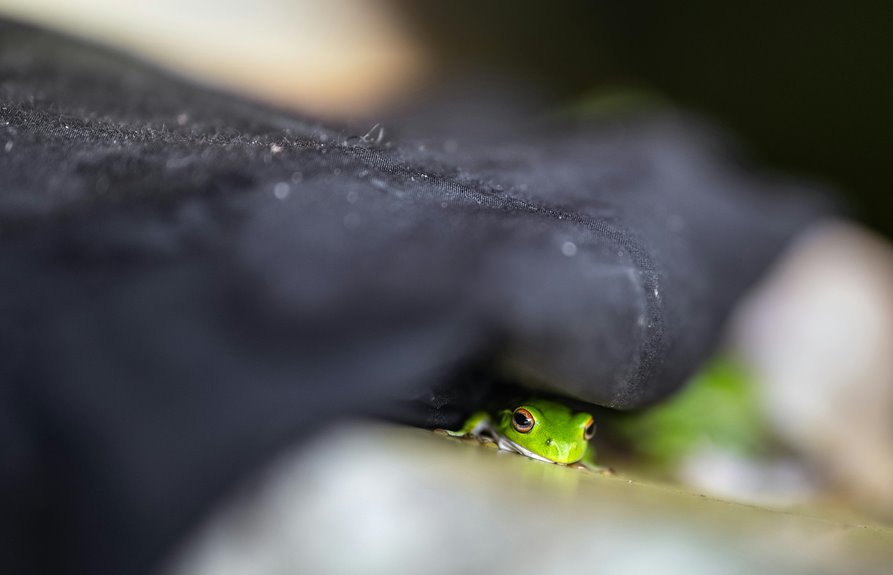Polycotton blends cotton’s softness and breathability with polyester’s strength and durability, typically in a 65/35 ratio. You get a wrinkle-resistant, comfortable fabric that’s easier to care for than pure cotton—it dries faster, resists shrinking, and lasts longer. It’s perfect for everyday clothes, uniforms, and home textiles like sheets or curtains. If you want to discover how polycotton stacks up against other fabrics and learn care tips, keep exploring its many benefits and uses.
Table of Contents
Key Takeaways
- Polycotton is a fabric blend typically made of 65% cotton and 35% polyester, combining comfort and durability.
- It offers wrinkle resistance, breathability, moisture absorption, and faster drying than pure cotton.
- Commonly used in clothing, uniforms, bedding, and home textiles for its soft yet strong qualities.
- Polycotton is cost-effective, easier to maintain, and more durable compared to pure cotton or polyester.
- Care involves gentle washing, low heat drying, and ironing on low, with environmental impacts tied to cotton and polyester production.
Understanding the Composition of Polycotton
Polycotton blends the best of two fibers—cotton and polyester—to create a fabric that’s both comfortable and durable.
When you wear or use polycotton, you’re benefiting from cotton’s softness and breathability paired with polyester’s strength and wrinkle resistance.
Typically, polycotton fabric consists of about 65% cotton and 35% polyester, though these ratios can vary depending on the intended use.
Polycotton blends typically feature around 65% cotton and 35% polyester, varying by purpose.
This combination means you get a fabric that’s easier to care for than pure cotton and less prone to shrinking or fading.
Plus, polycotton’s blend helps it dry faster, making it practical for everyday wear and home textiles.
Understanding this composition helps you appreciate why polycotton is popular for clothing, bedding, and uniforms.
The Manufacturing Process of Polycotton Fabric
You’ll start by blending cotton and polyester fibers to get the perfect balance.
Then, the fabric takes shape through weaving or knitting techniques that suit its intended use.
Finally, finishing treatments enhance its feel, durability, and appearance.
Fiber Blending Techniques
Blending fibers requires careful control to guarantee the final fabric combines the best qualities of both cotton and polyester.
You start by selecting the right ratio of fibers—commonly 65% polyester and 35% cotton, though it varies. Next, you mix the fibers thoroughly in a blending machine, making certain of an even distribution. This step is vital because uneven blending can lead to inconsistent texture and performance.
After blending, the fibers move to the carding process, where they’re disentangled and aligned into a thin web. You’ll notice how this prepares the blend for spinning into yarn.
Weaving and Knitting Methods
Although fiber blending sets the foundation, the fabric’s final texture and strength come from weaving and knitting methods.
When you’re choosing polycotton, understanding these processes helps you appreciate its durability and feel.
You’ll find two main techniques:
- Weaving: Interlacing warp and weft yarns creates a sturdy, smooth fabric, ideal for shirts and bed linens.
- Knitting: Looping yarns produces stretchier, softer material, perfect for t-shirts and casual wear.
- Plain Weave: The simplest weave, giving balanced strength and breathability.
- Twill Weave: Recognizable by diagonal patterns, offering extra durability and a unique look.
Finishing and Treatment Processes
Once the fabric is woven or knitted, manufacturers apply various finishing and treatment processes to enhance polycotton’s performance and appearance. These steps improve softness, durability, and resistance to wrinkles or stains. You’ll often find treatments tailored to specific uses, making polycotton even more versatile.
Here’s a quick look at common finishing techniques:
| Process | Purpose | Benefit |
|---|---|---|
| Mercerization | Improves dye absorption | Brighter, more vibrant colors |
| Calendering | Smooths fabric surface | Adds shine and softness |
| Resin Finishing | Adds wrinkle resistance | Keeps fabric crisp and neat |
Key Properties and Characteristics of Polycotton
Because polycotton combines the strengths of both polyester and cotton, it offers a unique set of properties that make it popular for various applications.
Polycotton blends polyester and cotton strengths, creating a fabric prized for versatility and performance.
When you choose polycotton, you get a fabric that’s easy to care for and durable, thanks to polyester’s resilience and cotton’s comfort. You’ll notice it’s breathable yet holds its shape well, giving you both comfort and longevity.
Here are some key characteristics you’ll appreciate:
- Wrinkle Resistance: It stays smoother longer than pure cotton.
- Moisture Absorption: It wicks away sweat better than polyester alone.
- Durability: It handles wear and tear without losing softness.
- Breathability: It keeps you comfortable by allowing airflow.
This balance makes polycotton a versatile fabric you can rely on every day.
Common Uses of Polycotton in Fashion and Home Textiles
The unique blend of comfort and durability in polycotton makes it a favorite choice in both fashion and home textiles.
When you pick polycotton for your wardrobe, you’ll find it used in shirts, dresses, and casual wear because it breathes well and resists wrinkles. You’ll also notice polycotton in uniforms and workwear thanks to its strength and easy maintenance.
At home, polycotton is common in bedding, like sheets and pillowcases, offering softness that holds up after many washes. It’s also popular for curtains and upholstery, where you want fabric that’s both attractive and long-lasting.
Whether updating your closet or revitalizing your living space, polycotton offers versatility that fits your everyday needs without compromising style or comfort.
Benefits of Choosing Polycotton Over Pure Cotton or Polyester
Although pure cotton and polyester each have their strengths, polycotton combines the best of both to give you enhanced comfort, durability, and ease of care.
Polycotton blends cotton’s comfort with polyester’s durability for a fabric that’s both soft and long-lasting.
When you choose polycotton, you get a fabric that feels soft like cotton but resists wrinkles and shrinking like polyester. This blend is perfect if you want something low-maintenance yet comfortable. Plus, it’s often more affordable than pure cotton without sacrificing quality.
Here’s why polycotton might be your best pick:
- Breathable and moisture-wicking for all-day comfort
- Stronger and more durable, lasting through many washes
- Resistant to wrinkles, keeping you looking sharp
- Affordable, blending quality with budget-friendly pricing
Polycotton truly offers a balanced fabric experience tailored for your everyday needs.
How to Care for Polycotton Clothing and Products
Caring for your polycotton clothing and products is simpler than you might think, requiring just a few straightforward steps to keep them looking their best.
Wash polycotton items in cold or warm water using a gentle cycle to protect the fibers and prevent shrinking. Avoid bleach, which can weaken the fabric and cause discoloration. Use a mild detergent and skip fabric softeners to maintain breathability.
When drying, opt for low heat or air drying to reduce wrinkles and extend the garment’s life. Iron on a low to medium setting if needed, as high heat can damage the blend.
Comparing Polycotton to Other Fabric Blends
When choosing fabric, you’ll want to weigh durability and comfort between polycotton and other blends.
You’ll also notice differences in cost efficiency that can impact your budget.
Plus, understanding maintenance needs will help you keep your clothes looking great longer.
Durability and Comfort Comparison
Because polycotton blends combine natural and synthetic fibers, you get a unique balance of durability and comfort that stands out from other fabric blends.
You’ll find polycotton more resistant to wear and tear than pure cotton, yet it still feels softer than many full synthetic fabrics.
When comparing, keep these points in mind:
- Polycotton resists wrinkles better than 100% cotton, saving you ironing time.
- It breathes more than polyester, keeping you comfortable in warmer weather.
- Its durability surpasses pure cotton, making it suitable for frequent use.
- While it offers softness, it mightn’t feel as plush as 100% cotton.
This balance makes polycotton a smart choice if you want longevity without sacrificing comfort.
Cost Efficiency Differences
Although you might initially focus on fabric feel or durability, cost efficiency plays a crucial role in choosing between polycotton and other blends.
Polycotton often offers a more budget-friendly option compared to pure cotton, thanks to its synthetic fiber content, which lowers production costs. You’ll find that polycotton provides good value because it balances quality and price, making it ideal for bulk purchases like uniforms or bedding.
While blends with higher synthetic percentages might be cheaper, they can sacrifice breathability and comfort. On the other hand, 100% cotton tends to be pricier but delivers premium softness and natural feel.
Ultimately, polycotton stands out by giving you a practical middle ground—cost-effective without severely compromising on comfort or durability.
Maintenance and Care Tips
Since care routines directly affect how long your fabric lasts, understanding the maintenance needs of polycotton compared to other blends is essential.
Polycotton is generally easier to care for than pure cotton or linen, thanks to its wrinkle resistance and durability. You can machine wash it without worrying about excessive shrinkage, unlike some natural fabrics.
Here’s how to keep your polycotton looking great:
- Wash in cold or warm water to avoid color fading and maintain fabric strength.
- Use a gentle cycle and mild detergent to protect the blend’s fibers.
- Tumble dry on low heat or air dry to prevent damage.
- Iron on a low setting if necessary, as polycotton resists wrinkles better than pure cotton.
Following these tips will keep your polycotton items lasting longer and looking fresh.
Environmental Impact and Sustainability of Polycotton
When you consider choosing polycotton, it’s important to understand how its production and disposal affect the environment.
Polycotton blends combine natural cotton with synthetic polyester, so their environmental impact reflects both materials. Cotton farming can be resource-intensive, requiring significant water and pesticides.
Polycotton blends reflect the environmental costs of both resource-heavy cotton farming and synthetic polyester production.
Meanwhile, polyester production relies on fossil fuels and releases greenhouse gases. When you wear or wash polycotton, microplastics from polyester can enter waterways, contributing to pollution.
On the upside, polycotton’s durability means garments often last longer, reducing waste. To minimize environmental harm, you can look for recycled polyester blends or organic cotton-polyester options.
Also, proper garment care extends life and lowers your carbon footprint. By understanding these factors, you make smarter, more sustainable choices with polycotton fabrics.
Tips for Shopping and Identifying Quality Polycotton Products
Understanding the environmental aspects of polycotton helps you appreciate why quality matters when shopping for these fabrics.
To make the best choice, you need to know what to look for. Here are some tips to guide you:
- Check the fabric blend ratio; a balanced mix (usually 65% cotton, 35% polyester) offers durability and comfort.
- Feel the fabric—quality polycotton should be smooth, not rough or overly synthetic.
- Inspect stitching and seams; well-made products last longer and resist pilling.
- Look for certifications or eco-labels that indicate sustainable production practices.
Frequently Asked Questions
Can Polycotton Cause Allergies or Skin Irritation?
You might experience allergies or skin irritation from polycotton if you’re sensitive to synthetic fibers or dyes used in the fabric. Always check the material blend and wash new clothes before wearing to reduce risks.
Is Polycotton Suitable for Athletic Wear?
You’ll find polycotton suitable for light athletic wear since it’s breathable and durable, but it doesn’t wick moisture as effectively as specialized fabrics, so for intense workouts, you might want something designed specifically for performance.
How Does Polycotton Fabric Behave in Extreme Weather Conditions?
When you wear polycotton in extreme weather, it almost battles the elements for you. It breathes enough to keep cool but isn’t great with heavy moisture or freezing cold, so you might want extra layers.
Can Polycotton Be Recycled or Repurposed Easily?
You can recycle or repurpose polycotton, but it’s tricky since it blends natural and synthetic fibers. You’ll find fewer recycling options, but creative upcycling projects like making cleaning rags or bags work well for you.
What Are the Common Myths About Polycotton Fabric?
You might’ve heard polycotton is uncomfortable or less durable, but that’s a myth. It’s actually breathable and strong. Also, people often assume it’s hard to care for, but you can wash it easily without worries.
- Where to Buy Sherpa Suede Fabric - July 12, 2025
- How to Draw or Illustrate the Texture of Suede Fabric - July 12, 2025
- What Is Baseball Suede Leather Fabric? - July 12, 2025







